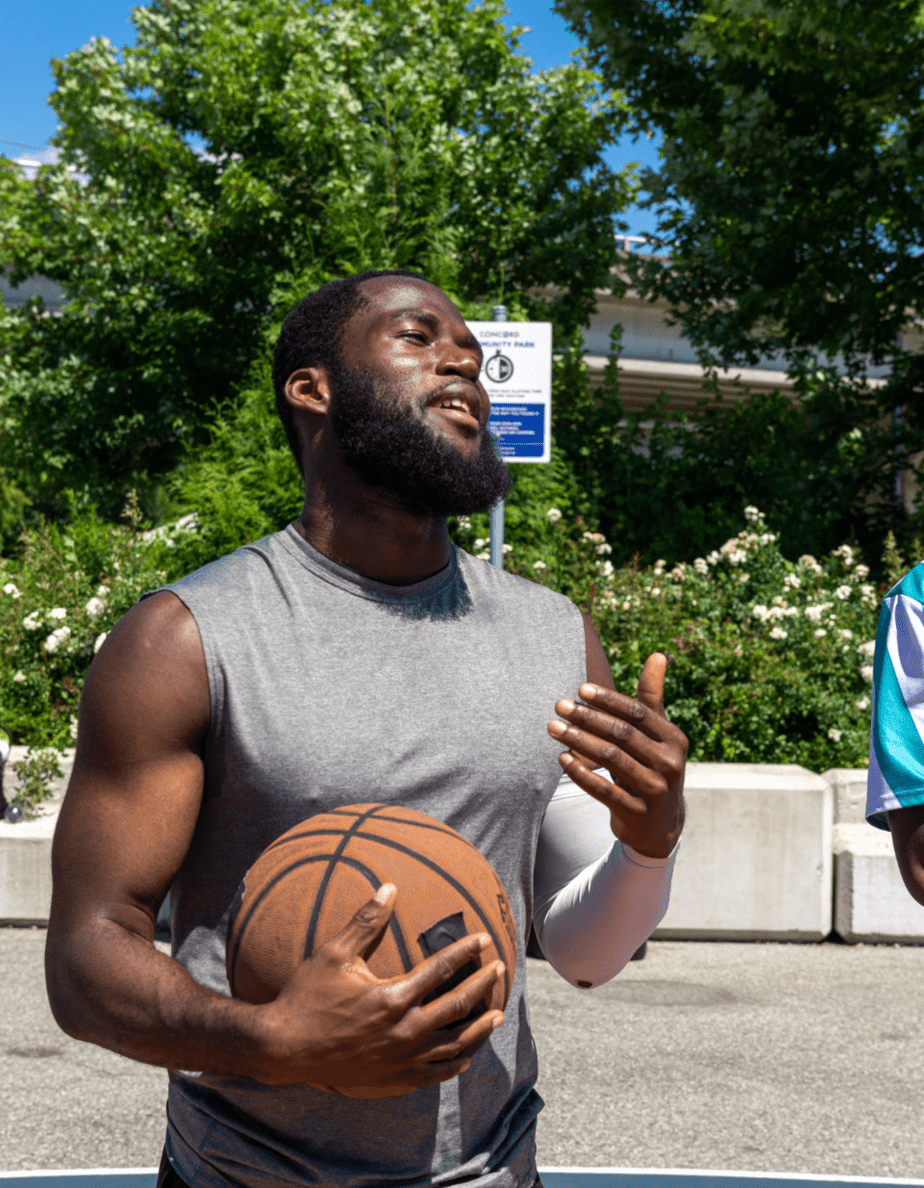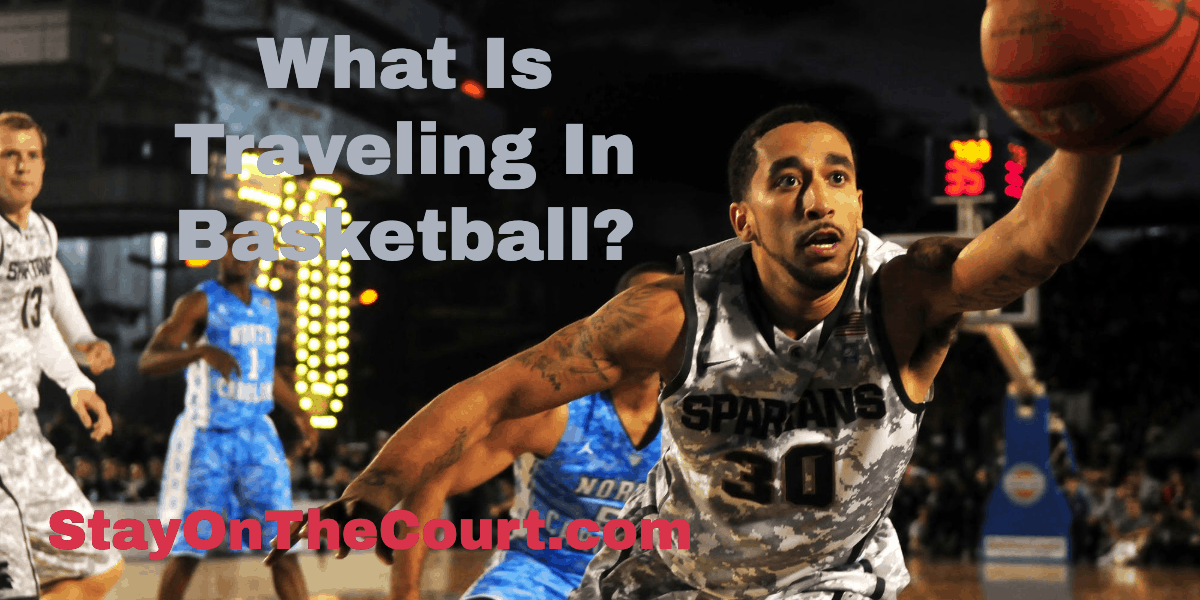What is Traveling in Basketball?
Traveling in basketball seems like a simple base concept. Does it really need an explanation? Yes, when you are trying to teach your 6-year-old son you have to be able to put it into words. This is not an article about AAU traveling basketball teams, although it is a big topic in its own right.
Sometimes a picture is worth a thousand words so a video may even be better. The video below gives you some detailed information on traveling in basketball and how not to do it (if that is your goal). Then continue reading to go deep and become a basketball traveling expert.
NBA Definition of Traveling in Basketball
The official NBA definition of traveling is much longer than you would think was needed. In Section 13 it goes like this:
- A player who receives the ball while standing still may pivot, using either foot as the pivot foot.
- A player who gathers the ball while progressing may take (1) two steps in coming to a stop, passing or shooting the ball, or (2) if he has not yet dribbled, one step prior to releasing the ball. A player who gathers the ball while dribbling may take two steps in coming to a stop, passing, or shooting the ball.
- The first step occurs when afoot, or both feet, touch the floor after gaining control of the ball.
- The second step occurs after the first step when the other foot touches the floor, or both feet touch the floor simultaneously.
- A player who comes to a stop on step one when both feet are on the floor or touch the floor simultaneously may pivot using either foot as his pivot. If he jumps with both feet he must release the ball before either foot touches the floor.
- A player who lands with one foot first may only pivot using that foot.
- A progressing player who jumps off one foot on the first step may land with both feet simultaneously for the second step. In this situation, the player may not pivot with either foot and if one or both feet leave the floor the ball must be released before either return to the floor.
- In starting a dribble after (1) receiving the ball while standing still, or (2) coming to a legal stop, the ball must be out of the player’s hand before the pivot foot is raised off the floor.
- If a player, with the ball in his possession, raises his pivot foot off the floor, he must pass or shoot before his pivot foot returns to the floor. If he drops the ball while in the air, he may not be the first to touch the ball.
- A player who falls to the floor while holding the ball, or while coming to a stop, may not gain an advantage by sliding.
- A player who attempts a field goal may not be the first to touch the ball if it fails to touch the backboard, basket ring or another player.
- A player may not be the first to touch his own pass unless the ball touches his backboard, basket ring or another player.
- Upon ending his dribble or gaining control of the ball, a player may not touch the floor consecutively with the same foot (hop).
- PENALTY: Loss of ball. The ball is awarded to the opposing team on the sideline, nearest spot of the violation but no nearer the baseline than the foul line extended.
If you ever watch NBA basketball you know it is rarely called in the NBA but it can be a frequent call made in lower levels of basketball, especially in leagues where younger players are still learning.
Traveling is a violation in basketball in which the player in control of the ball, but not dribbling, makes an illegal move with their feet. A traveling violation results in a turnover, which means that the ball is awarded to the other team. Sounds pretty simple right? There are quite a few situations in which a traveling call can be made, so let’s take a closer look at what a traveling violation really is.
Key Points of Traveling In Basketball
A traveling violation can be called in several situations. There are differences in rules between youth, high school, college, and professional leagues. Here are some items Let’s take a look at some items that are common to traveling in many leagues.
- Traveling calls involve the illegal movement of the pivot foot.
- You can’t travel while dribbling.
- Only a player who is in control of the ball can travel.
- A player must be inbounds in order to travel.
Announcers look for more creative terms for traveling like “walking”, “taking steps” or I am sure legendary announcer Bill Raftery has some additional creative terms. “Up and Down” is used when a player leaves the floor and lands without passing or shooting the ball.
Pivot Foot
What is a pivot foot when we talk about traveling in basketball?
The pivot foot is a single foot (can be left or right) which must remain in contact with the floor (like an anchor). Players are allowed to spin on a pivot foot as long as it remains in the same spot and does not slide across the floor.
As long as the player has the ball the pivot foot must remain in contact with the floor while not dribbling or jumping into the air to shoot or pass the ball. The establishment of a pivot foot is important in determining a traveling call. See any Villanova basketball team over the last 10 years for textbook use of the jump stop and pivot foot.
A pivot foot is established when a player is stationary with the ball (not dribbling). Once one foot is moved, the other foot becomes the pivot foot. If a player lands on one foot first, the first foot to contact the floor is considered the pivot foot.
Pivot foot rules are a little different from league to league. There are more details on pivot foot establishment here.
Do These And You Are Traveling
Steer clear of these types of movements in most basketball leagues to avoid traveling:
- Lifting of the pivot foot if one has been established.and returning it to the floor before passing or shooting.
- Lifting of the pivot foot before releasing the ball to dribble.
- Dragging or sliding either foot if no pivot foot is available.
- A fall to the floor without maintaining a pivot foot.
- Rolling on the floor.
- Lifting both feet from the floor (jumping) and returning either foot to the floor before passing or shooting.
- Dragging or sliding the pivot foot.
Examples of Traveling
Pivot Slide – A player is spinning or stretching and their pivot foot slides across the floor.
Up and Down – A player leaves the floor attempting to pass or shoot but never releases the ball and comes back down to the floor.
Three-Point Steps – A player gets the ball in front of the 3-point line and steps back behind the line to shoot without dribbling. If the player lifts the pivot foot it is a traveling violation.
Rebound Shuffle – A player gets a rebound and shuffles their feet or falls down.
Early Step – This is one of the most common violations. The player never thinks he is guilty. It often happens when a player is attempting to drive to the basket from a static position. A player takes a step and lifts the pivot foot before releasing the ball to dribble.
These are just a few of the ways you can travels. There are all kinds of variations. Traveling can be complicated and is the cause of many pick up basketball game arguments. Everyone on the court, and in the stands, has their interpretation of it.
The Euro-Step
The “Euro-Step” has become commonplace in the NBA and basketball in general. It can look like, and be mistaken for traveling. The player picks up their dribble while taking a step in one direction, and then takes a second step in the other direction to avoid a defensive player. Since the second step is considered a continuation of the original move off of the dribble, it is not a violation.
A New York Times article notes that Lithuanian Sarunas Marciulionis was one of the first players to bring the move to the NBA in the 1990s. Manu Ginobili, an Argentinian who played for the San Antonio Spurs also popularized the move. The Euro-step is now used in the NBA, college, and high school.
References And Resources
Understanding all of the details and rules of traveling can be very important when trying to determine a true traveling violation. Take a look at this source to see more details on rules, pivot foot establishment, and things that are allowed by different leagues. You may be surprised to learn that many of the moves you think are a violation, really are legal.
If you are interested in seeing more information on the different traveling rules in different leagues take a look here for a good summary.
A visual explanation can also be helpful to see the differences in legal and illegal moves. Take a look at this video to help you visualize what a traveling violation looks like.
Summary
Playing basketball without traveling is fundamental to basketball. Teach your kids early when they are learning the game of basketball. One final thing to note, it is not traveling in NCAA play when a player falls to the ground with the ball. In NBA play, it is considered traveling.
Some critics say the NBA allows its players to get away with traveling too much. While there are often missed or overlooked calls, the skill and speed of NBA players really make it tough for the referees to make the call.
Check out our post on an illegal screen in basketball for all the rules, tips, and tricks.
Does the NBA call enough traveling? Let us know? We’d love to know what you think (comment below)!
Troy Wright
I am a lifetime basketball enthusiast and loved playing basketball competitively through high school. I still try and play at least 3 times a week and explore all kinds of equipment and training to keep myself on the court and continually getting better. I am a college basketball fanatic and move onto the NBA when March Madness ends.
Meaningful conversations happening daily about training, recovery, and injury-specific rehabilitation as well as sport-specific discussions on playing, coaching and refereeing your favorite sport. We welcome experts and those with curious minds seeking answers.
Join The Stay On The Court Community!
